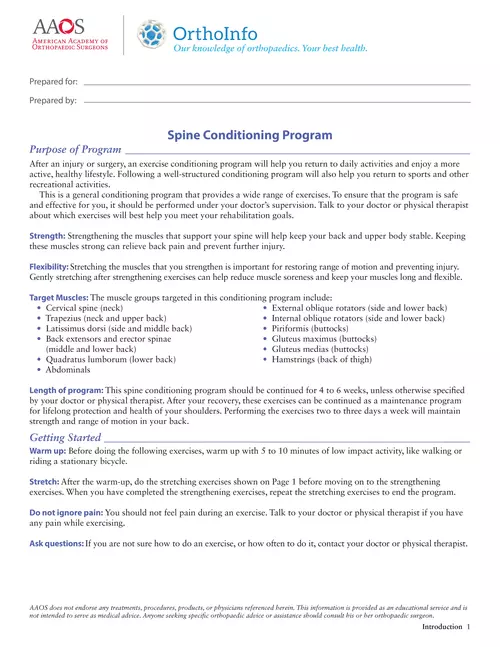
the AAOS Spine Conditioning Program - OrthoInfo - American
SACROILIAC JOINT DYSFUNCTION MANAGEMENT AND TREATMENT. Sacroiliac The sacroiliac joint (SIJ) is made up of main focus of these exercises should be.
adsPart of the document
Introduction 1
AAOS does not endorse any treatments, procedures, products, or physicians referenced herein. This information is provided as an educational service and is
not intended to serve as medical advice. Anyone seeking speci?c orthopaedic advice or assistance should consult his or her orthopaedic surgeon.
Prepared for:
Prepared by:
Our knowledge of orthopaedics. Your best health.
Spine Conditioning Program
Purpose of Program
_________________________________________________________________
After an injury or surgery, an exercise conditioning program will help you return to daily activities and enjoy a more
active, healthy lifestyle. Following a well-structured conditioning program will also help you return to sports and other
recreational activities.
This is a general conditioning program that provides a wide range of exercises. To ensure that the program is safe
and effective for you, it should be performed under your doctor's supervision. Talk to your doctor or physical therapist
about which exercises will best help you meet your rehabilitation goals.
Strength
Strengthening the muscles that support your spine will help keep your back and upper body stable. Keeping
these muscles strong can relieve back pain and prevent further injury.
Flexibility: Stretching the muscles that you strengthen is important for restoring range of motion and preventing injury.
Gently stretching after strengthening exercises can help reduce muscle soreness and keep your muscles long and ?exible.
Target Muscles:
The muscle groups targeted in this conditioning program include: • Cervical spine (neck)• Trapezius (neck and upper back)• Latissimus dorsi (side and middle back)• Back extensors and erector spinae (middle and lower back)
•
Quadratus lumborum (lower back)
•
Abdominals• External oblique rotators (side and lower back)• Internal oblique rotators (side and lower back)• Piriformis (buttocks)• Gluteus maximus (buttocks)• Gluteus medias (buttocks)• Hamstrings (back of thigh)
Length of program:
This spine conditioning program should be continued for 4 to 6 weeks, unless otherwise speci?ed
by your doctor or physical therapist. After your recovery, these exercises can be continued as a maintenance program
for lifelong protection and health of your shoulders. Performing the exercises two to three days a week will maintain
strength and range of motion in your back.
Getting Started


